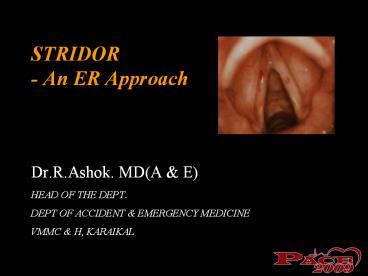STRIDOR - An ER Approach
1 / 32
Title:
STRIDOR - An ER Approach
Description:
... Vocal cord paralysis, congenital lesions such as choanal atresia, laryngeal web and vascular ring 4 to 6 weeks: Laryngomalacia 1 to 4 years: Croup, ... – PowerPoint PPT presentation
Number of Views:27
Avg rating:3.0/5.0
Title: STRIDOR - An ER Approach
1
STRIDOR- An ER Approach
- Dr.R.Ashok. MD(A E)
- HEAD OF THE DEPT.
- DEPT OF ACCIDENT EMERGENCY MEDICINE
- VMMC H, KARAIKAL
2
Case Scenario
- A 6 year old boy was well until he woke from
sleep at 3am with a high fever. His mother
brought him to the ED because he was unable to
lie down, had noisy respirations, and was
drooling saliva.
3
- What is Stridor?
4
- Stridor is the sound produced by turbulent flow
of air through a narrowed segment of the
respiratory tract - It typically originates from the larynx (voice
box) or trachea (windpipe)
5
- What are the causes of Stridor ?
6
- Congenital anomalies of the larynx, trachea, and
bronchial tree - Foreign body aspiration
- Infectious conditions of the respiratory tract
- Vocal cord paralysis
- Trauma
7
- Neoplasms of the airway
- Allergic reaction
- Inhalation injury
- Prolonged intubation
- Diagnostic tests such as bronchoscopy or
laryngoscopy
8
- How is stridor evaluated?
9
Historical information in the Evaluation of
Stridor in Children
- Age of onset
- Birth Vocal cord paralysis, congenital lesions
such as choanal atresia, laryngeal web and
vascular ring - 4 to 6 weeks Laryngomalacia
- 1 to 4 years Croup, epiglottitis, foreign
body aspiration
10
- Chronicity
- Acute onset Foreign body aspiration,
infections such as croup and epiglottitis - Long duration Structural lesion such as
laryngomalacia, laryngeal web or larynogotracheal
stenosis
11
Precipitating factors
- Worsening with straining or crying
- Laryngomalacia, Subglottic Hemangioma
- Worsening at night Viral or spasmodic croup
- Worsening with feeding
- Tracheoesophageal fistula, Tracheomalacia,
- Neurologic disorder, Vascular compression
12
- Antecedent upper respiratory tract
- infection Croup, bacterial tracheitis
- Choking Foreign body aspiration,
- Tracheoesophageal fistula
13
Associated symptoms
- Barking cough Croup
- Brassy cough Tracheal lesion
- Drooling Epiglottitis,
- Foreign body in
esophagus, - Retropharyngeal or
- Peritonsillar abscess
- Weak cry Laryngeal anomaly or
- Neuromuscular disorder
14
- Muffled cry Supraglottic lesion
- Hoarseness Croup, vocal cord paralysis
- Snoring Adenoidal or
- Tonsillar Hypertrophy
- Dysphagia Supraglottic lesion
15
Past Health
- Endotracheal Intubation
- Birth trauma, perinatal asphyxia,
- Cardiac problem
- Psychosocial History
- Psychosocial stress - Psychogenic stridor
16
(No Transcript)
17
Physical Examination
- General
- Cyanosis - Cardiac disorder,
- Hypoventilation with
hypoxia - Fever - Underlying infection
- Toxicity - Epiglottitis
- Tachycardia - Cardiac failure
- Bradycardia - Hypothyroidism
18
Quality of Stridor
- Inspiratory stridor - Obstruction above glottis
- Expiratory stridor - Obstruction at or below
lower trachea - Biphasic stridor - Glottic or subglottic lesion12
19
Position of child
- Hyperextension of the neck
- Extrinsic obstruction at or above
- larynx
- Leaning over, drooling
- Epiglottitis
- Lessening of stridor in prone
- position - Laryngomalacia
20
Chest Finding
- Prolonged inspiratory phase
- Laryngeal obstruction
- Prolonged expiratory phase
- Tracheal obstruction
- Unilateral decreased air entry
- Foreign body in ipsilateral bronchus
21
Signs of Impending Respiratory Failure
- Increased work of breathing with tiring
- Increasing tachypnea and tachycardia
- Abrupt onset of bradycardia
- Cyanosis
- Marked lethargy or unresponsiveness
22
Initial approach to a Stridorous child
- Avoid disturbing or upsetting the child
- Avoid tongue depressor or other oral instruments
- Confirm the diagnosis by direct or radiographic
visualisation
23
Diagnosis
- History and Physical examination
- Chest and neck x-rays, bronchoscopy, CT-scans,
and / or MRIs may reveal structural pathology - Flexible fiberoptic bronchoscopy
24
Parents or caregivers may be asked..?
- Is the abnormal breathing a high-pitched sound?
- Did the breathing problem start suddenly?
- Could the child have put something in the mouth?
- Has the child been ill recently?
- Is the child's neck or face swollen?
25
Parents or caregivers may be asked..?
- Has the child been coughing or complaining of a
sore throat? - What other symptoms does the child have? (For
example, nasal flaring or bluish color to the
skin, lips, or nails) - Is the child using chest muscles to breathe
(intercostal retractions)?
26
- How will you approach this in the ER?
27
- Tracheal intubation or Tracheostomy is
immediately necessary?
28
- Expectant management with full monitoring, oxygen
by face mask, and positioning the head of the bed
for optimum conditions (e.g., 45 - 90 degrees) - Use of nebulized racemic adrenaline (0.5 to 0.75
ml of 2.25 racemic adrenaline added to 2.5 to 3
ml of normal saline) in cases where airway edema
may be the cause of the stridor
29
- Use of dexamethasone (Decadron) 4-8 mg IV q 8 -
12 h in cases where airway oedema may be the
cause of the stridor - Use of inhaled Heliox (70 helium, 30 oxygen)
the effect is almost instantaneous. Helium, being
a less dense gas than nitrogen, reduces turbulent
flow through the airways
30
- Nebulized Cocaine in a dose not exceeding 3 mg/kg
may also be used, but not together with racemic
adrenaline because of the risk of ventricular
arrhythmias
31
Remember
- Stridor is a symptom and not a diagnosis
- History and physical are key in diagnosis
- Airway endoscopy is an important adjunct
- Proper management is possible only after a
precise diagnosis has been established
32
Thank you































